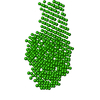+Search query
-Structure paper
| Title | A novel Porphyromonas gingivalis enzyme: An atypical dipeptidyl peptidase III with an ARM repeat domain. |
|---|---|
| Journal, issue, pages | PLoS One, Vol. 12, Issue 11, Page e0188915, Year 2017 |
| Publish date | Nov 30, 2017 |
 Authors Authors | Altijana Hromić-Jahjefendić / Nina Jajčanin Jozić / Saša Kazazić / Marina Grabar Branilović / Zrinka Karačić / Jörg H Schrittwieser / Krishna Mohan Padmanabha Das / Marko Tomin / Monika Oberer / Karl Gruber / Marija Abramić / Sanja Tomić /    |
| PubMed Abstract | Porphyromonas gingivalis, an asaccharolytic Gram-negative oral anaerobe, is a major pathogen associated with adult periodontitis, a chronic infective disease that a significant percentage of the ...Porphyromonas gingivalis, an asaccharolytic Gram-negative oral anaerobe, is a major pathogen associated with adult periodontitis, a chronic infective disease that a significant percentage of the human population suffers from. It preferentially utilizes dipeptides as its carbon source, suggesting the importance of dipeptidyl peptidase (DPP) types of enzyme for its growth. Until now DPP IV, DPP5, 7 and 11 have been extensively investigated. Here, we report the characterization of DPP III using molecular biology, biochemical, biophysical and computational chemistry methods. In addition to the expected evolutionarily conserved regions of all DPP III family members, PgDPP III possesses a C-terminal extension containing an Armadillo (ARM) type fold similar to the AlkD family of bacterial DNA glycosylases, implicating it in alkylation repair functions. However, complementation assays in a DNA repair-deficient Escherichia coli strain indicated the absence of alkylation repair function for PgDPP III. Biochemical analyses of recombinant PgDPP III revealed activity similar to that of DPP III from Bacteroides thetaiotaomicron, and in the range between activities of human and yeast counterparts. However, the catalytic efficiency of the separately expressed DPP III domain is ~1000-fold weaker. The structure and dynamics of the ligand-free enzyme and its complex with two different diarginyl arylamide substrates was investigated using small angle X-ray scattering, homology modeling, MD simulations and hydrogen/deuterium exchange (HDX). The correlation between the experimental HDX and MD data improved with simulation time, suggesting that the DPP III domain adopts a semi-closed or closed form in solution, similar to that reported for human DPP III. The obtained results reveal an atypical DPP III with increased structural complexity: its superhelical C-terminal domain contributes to peptidase activity and influences DPP III interdomain dynamics. Overall, this research reveals multifunctionality of PgDPP III and opens direction for future research of DPP III family proteins. |
 External links External links |  PLoS One / PLoS One /  PubMed:29190734 / PubMed:29190734 /  PubMed Central PubMed Central |
| Methods | SAS (X-ray synchrotron) |
| Structure data |  SASDC58: |
| Source |
|
 Movie
Movie Controller
Controller Structure viewers
Structure viewers About Yorodumi Papers
About Yorodumi Papers



 Porphyromonas gingivalis (strain atcc baa-308 / w83) (bacteria)
Porphyromonas gingivalis (strain atcc baa-308 / w83) (bacteria)